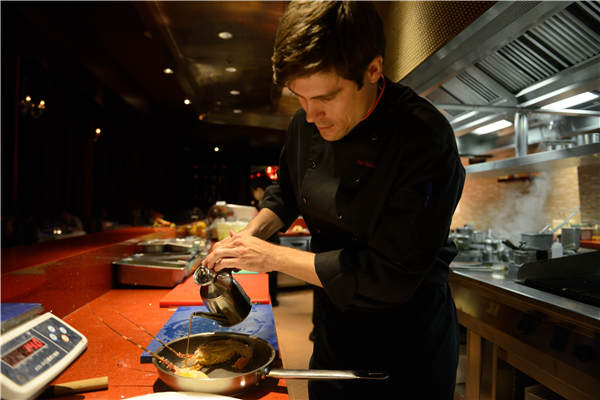Get set for food carnival
Updated: 2016-05-20 07:32
By Mike Peters(China Daily)
|
|||||||||
 |
|
Chef Erik Nako prepares Lobster Bobo, a grilled crustacean surrounded by pureed cassava and other Brazilian produce. |
"It's a major staple all over the country," he says, "and from it we get all sorts of flours and subproducts such as bread and tapioca (pudding)." Cassava fries are popular, and fans say they can be eaten without fear of weight gain.
Later, when Nako grills a lobster for a dish he's planned for the festival, he will start creating the plate with an artistically smeared scoop of yellow cassava puree.
But first, he's recalling the shopping list of ingredients amid that 140 kilos of produce he's brought.
"Brazil's food is a little bit like China's, in that the country is so large and has many culinary influences," he says. Many are indigenous, as the chef illustrates by identifying various foods and dishes by their faintly musical tribal names. Other influences come from colonial days, the African slave trade and waves of immigration.
"Around Sao Paulo there are German and Italian influences, in the northeast it's more Dutch - and of course there is Portuguese all over, so you find sweets with egg yolk. With that mix we end up with a cuisine that is all about color and freshness."
Tropical areas of Brazil boast flavors that would be familiar in southern China: ginger, coconut, banana.
Other items are so region-specific, however, that Nako promises that even many Brazilians won't recognize them.
But most foods and dishes will make any expats from the country homesick, like feijoada, the famous Brazilian stew. In the chef's hometown of Rio, black beans and white rice form its base, while in other parts of the country, black beans give way to red kidney beans.
Related Stories
Time-honored brands featured in short movies project 2016-05-19 11:14
Adorable Mickey Mouse dish brings delight 2016-05-17 11:00
World's oldest tea on display in NW China 2016-05-16 09:58
Salad delivery service launches online shopping platform 2016-05-12 13:53
Global chain's latest mainland eatery keeps popular fare coming 2016-05-10 08:40
Today's Top News
Still learning
EgyptAir denies finding wreckage of missing flight
China urges US to halt close surveillance
Debris found in sea in search for missing MS804
LinkedIn matches refugees with jobs
Top legislator foresees bright future for SAR
UN climate talks resume to write 'rule book'
Internet regulations: From the US to Australia
Hot Topics
Lunar probe , China growth forecasts, Emission rules get tougher, China seen through 'colored lens', International board,
Editor's Picks

|

|

|

|

|

|







